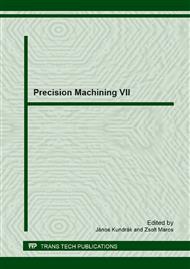p.437
p.443
p.451
p.456
p.462
p.466
p.472
p.478
p.485
Tool Profile Generation by Boolean Operations on Ball Nuts
Abstract:
Ballscrew drive mechanisms are widely used in the transmitting system of precision machine tools. The profile of the ball nut is a gothic curve combined by two equal radius arcs with offset centers. Most of gothic arc ball nuts are manufactured by form grinding, where the grinding wheel is shaped into the desired profile and the tool axis is tilted at the lead angle of the ball nut thread. In case of the internal ball nut grinding the high lead angle and long thread limits the manufacturing process. To avoid the collision between the internal surface of the workpiece and outer surface of the quill the optimal tilt angle is modified. The modified tilt angle affects to the profile of the formed grinding wheel. This paper presents a method for the generation of modified grinding wheel profile independently the tilt angle. The desired profile points are generated by solid boolean operations with programming of a parametric CAD system.
Info:
Periodical:
Pages:
462-465
Citation:
Online since:
October 2013
Authors:
Keywords:
Price:
Сopyright:
© 2014 Trans Tech Publications Ltd. All Rights Reserved
Share:
Citation:


